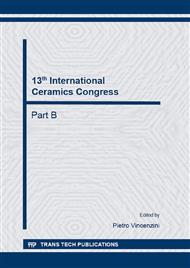[1]
J.F. Yang, G.J. Zhang, T. Ohji, Fabrication of low-shrinkage, porous silicon nitride ceramics by addition of a small amount of carbon, J. Am. Ceram. Soc. 84 (2001) 1639-1641.
DOI: 10.1111/j.1151-2916.2001.tb00890.x
Google Scholar
[2]
A. Kalemtas, G. Topates, H. Ozcoban, H. Mandal, F. Kara, R. Janssen, Mechanical characterization of highly porous β-Si3N4 ceramics fabricated via partial sintering & starch addition, J. Eur. Ceram. Soc. 33 (2013) 1507-1515.
DOI: 10.1016/j.jeurceramsoc.2012.10.036
Google Scholar
[3]
J. Yue, B. Dong, H. Wang, Porous Si3N4 fabricated by phase separation method using benzoic acid as pore-forming agent, J. Am. Ceram. Soc. 94 (2011) 1989-(1991).
DOI: 10.1111/j.1551-2916.2011.04611.x
Google Scholar
[4]
J. Yang, J.F. Yang, S.Y. Shan, J.Q. Gao, T. Ohji, Effect of sintering additives on microstructure and mechanical properties of porous silicon nitride ceramics, J. Am. Ceram. Soc. 89 (2006) 3843-3845.
DOI: 10.1111/j.1551-2916.2006.01294.x
Google Scholar
[5]
S.Y. Shan, J.F. Yang, Y. Lu, J.Q. Gao, K. Niihara, Effects of carbon source on microstructural evolution and sintering behavior of porous silicon nitride ceramics, Scripta Mater. 56 (2007 193-196.
DOI: 10.1016/j.scriptamat.2006.10.012
Google Scholar
[6]
S. Ding, Y.P. Zeng, D. Jiang, Oxidation bonding of porous silicon nitride ceramics with high strength and low dielectric constant, Mater. Lett. 61 (2007) 2277-2280.
DOI: 10.1016/j.matlet.2006.08.067
Google Scholar
[7]
C. Zou, C. Zhang, B. Li, S. Wang, F. Cao, Microstructure and properties of porous silicon nitride ceramics prepared by gel-casting and gas pressure sintering, Mater. Design 44 (2013) 114-118.
DOI: 10.1016/j.matdes.2012.07.056
Google Scholar
[8]
J. Yu, J. Yang, H. Li, Y. Huang, Pore structure control of Si3N4 ceramics based on particle-stabilized foams, J. Porous Mater. 19 (2012) 883-888.
DOI: 10.1007/s10934-011-9545-y
Google Scholar
[9]
T. Fukasawa, Z.Y. Deng, M. Ando, T. Ohji, S. Kanzaki, Synthesis of porous silicon nitride with unidirectionally aligned channels using freeze-drying process, J. Am. Ceram. Soc. 85 (2002) 2151-2155.
DOI: 10.1111/j.1151-2916.2002.tb00426.x
Google Scholar
[10]
F. Chen, Q. Shen, F. Yan, L. Zhang, Pressureless sintering of α-Si3N4 porous ceramics using a H3PO4 pore-forming agent, J. Am. Ceram. Soc. 90 (2007) 2379-2383.
DOI: 10.1111/j.1551-2916.2007.01800.x
Google Scholar
[11]
D. Zhang, L. Qi, J. Ma, H. Cheng, Synthesis of submicrometer-sized hollow silver spheres in mixed polymer-surfactant solutions, Adv. Mater. 14 (2002) 1499-1502.
DOI: 10.1002/1521-4095(20021016)14:20<1499::aid-adma1499>3.0.co;2-5
Google Scholar
[12]
L. Wang, Y. Ebina, K. Takada, T. Sasaki, Ultrathin hollow nanoshells of manganese oxide, Chem. Commun. (2004) 1074-1075.
DOI: 10.1039/b402209b
Google Scholar
[13]
C. Augustin, W. Hungerbach, Production of hollow spheres (HS) and hollow sphere structures (HSS), Mater. Lett. 63 (2009) 1109-1112.
DOI: 10.1016/j.matlet.2009.01.015
Google Scholar
[14]
I. Thijs, J. Luyten, S. Mullens, Producing ceramic foams with hollow spheres, J. Am. Ceram. Soc. 87 (2004) 170-172.
DOI: 10.1111/j.1151-2916.2004.tb19965.x
Google Scholar
[15]
J.M. Wu, X.Y. Zhang, J.L. Yang, Novel porous Si3N4 ceramics prepared by aqueous gelcasting using Si3N4 poly-hollow microspheres as pore-forming agent, J. Eur. Ceram. Soc. 34 (2014) 1089-1096.
DOI: 10.1016/j.jeurceramsoc.2013.11.025
Google Scholar
[16]
J. Yu, J. Yang, S. Li, H. Li, Y. Huang, Preparation of Si3N4 foam ceramics with nest-like cell structure by particle-stabilized foams, J. Am. Ceram. Soc. 95 (2012) 1229-1233.
DOI: 10.1111/j.1551-2916.2011.05017.x
Google Scholar
[17]
H. Wang, J. Yu, J. Zhang, D. Zhang, Preparation and properties of pressureless-sintered porous Si3N4, J. Mater. Sci. 45 (2010) 3671-3676.
DOI: 10.1007/s10853-010-4412-9
Google Scholar


